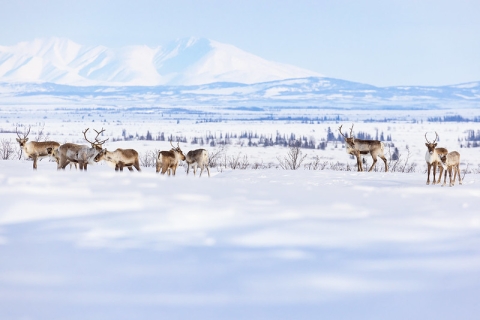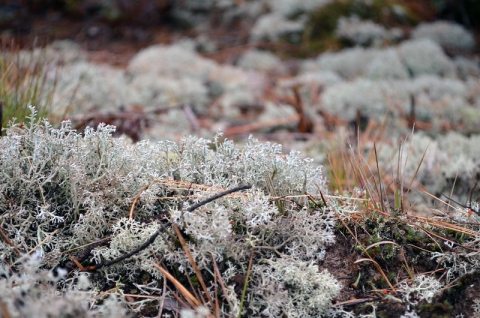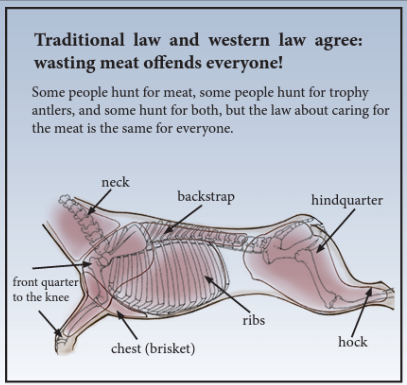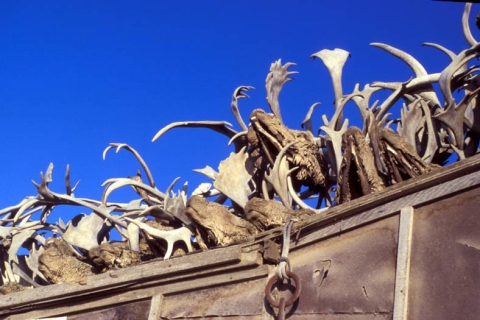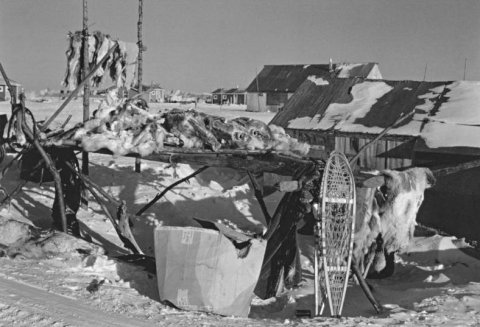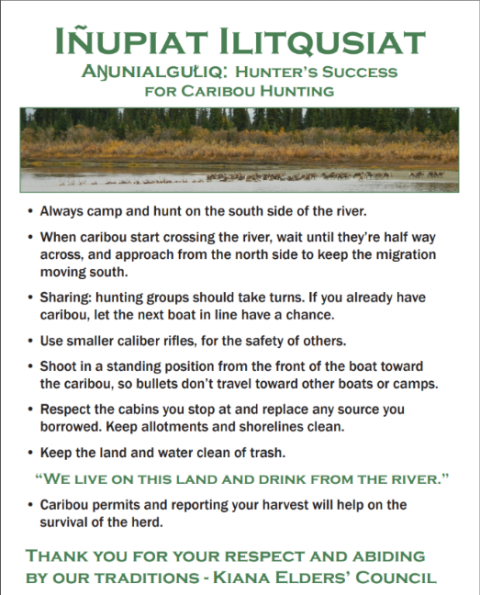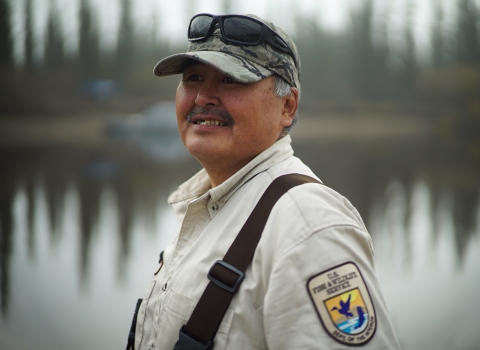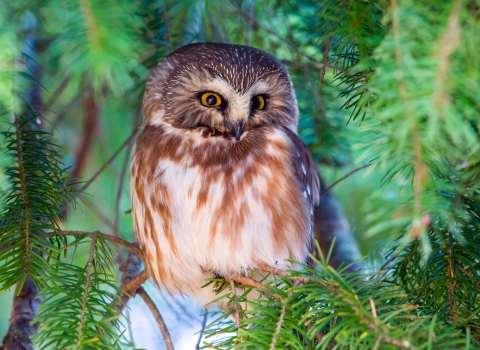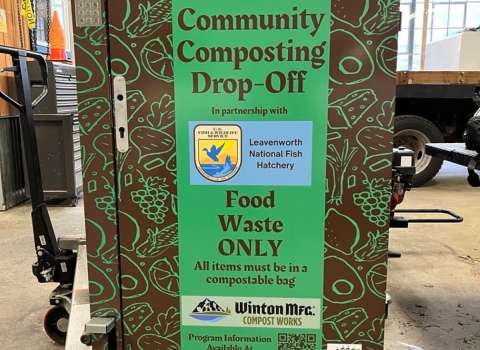The tuttu flowed down the foothills of the Waring Mountains as if they were a natural part of the land itself – the caribou stampeding southward across undulating hills and tundra wetlands, over dry brown grasses and white patches of lichen, their course approaching the soon-to-freeze Selawik River.
When the caribou emerged on the near side of its banks, they left behind the boundary of the Arctic Circle and continued through a new one – the Selawik National Wildlife Refuge – drawn instinctually further south to their overwintering range.
Witnessing the Western Arctic Caribou Herd’s fall migration through Selawik – part of the longest land migration on earth – and springtime return north, has remained “one of my greatest memories,” says Brittany Sweeney, an outreach specialist with the refuge.
Cyrus Harris also cherishes his memories of caribou migrations, especially those with which he grew up. Born in 1957 in Sisualik – an Iñupiaq village found 12 miles from Kotzebue, across Kotzebue Sound – he remembers the cooling air of late August and September coinciding with the gathering of dog teams and the revving of then-new-fangled snow machine engines.
The Western Arctic Herd, responding to the temperature drop, left their calving grounds and moved southward like clockwork each Labor Day weekend, “traveling right through our backyard,” he recalls.
Harris was around 10 years old when he set out on foot to experience his first harvest, traveling towards the foothills a few miles northeast of Sisualik, where Iñupiaq communities had gathered caribou for countless autumns before.
“Sometimes I would take a boat and go and hunt on the Kobuk River,” Harris says. “And of course, Onion Portage would be the place to go. It was where the main herds continuously crossed, and we took what we needed.”
Paatitaaq, or Onion Portage, an important site in this traditional land, is where Harris followed in the footsteps of countless others before him. Thousands of years of archaeological evidence of caribou hunting has been recorded at the site, a place where, since time immemorial, young harvesters have learned from those with more experience. “Living in Sisualik,” Harris says, “we’re all one."
Paatitaaq is also where biologists, including those with the U.S. Fish and Wildlife Service, would trek for decades to complete collaring projects and other caribou studies, Sweeney says. In need of stability amidst the many variables for which they were testing, scientists could always count on the herd’s reliable river crossing.
But these vibrant memories and stable journeys are beginning to fade into the passage of time. The migrations Sweeney and Harris treasure haven’t occurred with nearly the same regularity or timing for the past decade, and the herd's numbers are dwindling.
This double whammy is attributable to a changing climate in the tundra, says Alex Whiting, the Native Village of Kotzebue’s environmental program director.
As of July 2023, the Western Arctic Caribou Herd was numbered at 152,000, down from 188,000 in 2021 and 500,000 in 2003.
This smaller herd has restricted its range and isn’t migrating as far south. Instead, the caribou are stopping and overwintering in Selawik Refuge itself, if they even come down that far. Many animals are opting instead to winter in the mountains, keeping north of the Kobuk River and refuge lands. “It’s denying people [in Kotzebue] almost any fall-time opportunity to harvest,” Whiting says.
Paatitaaq today is often quiet in the fall, empty of caribou, hunting parties, and scientists alike. The cultural, environmental, and economic losses such change has caused is profound.
“[Our land] is being disturbed,” Harris says. “We’re dealing with climate change climate change
Climate change includes both global warming driven by human-induced emissions of greenhouse gases and the resulting large-scale shifts in weather patterns. Though there have been previous periods of climatic change, since the mid-20th century humans have had an unprecedented impact on Earth's climate system and caused change on a global scale.
Learn more about climate change , just as everywhere else on Earth. But it hits us harder.”
More Change Than We're Used To
The impacts of warming on Selawik Refuge are significant. Research shows that the effects of climate change in the Arctic – and on the Western Arctic Herd, one of the largest caribou herds on Earth and Alaska’s biggest – are twice as impactful compared to the rest of the world.
“At the same time that herd numbers are down, and their range is smaller, we see the weather not getting as cold in the fall,” Sweeney says. “We’re seeing changes in the tundra habitat.”
One of the most drastic changes is the delayed arrival of autumn and winter. Caribou begin their migration when the weather starts to get cold. But freezing temperatures are being experienced 30 to 45 days later each year on average, both Harris and Whiting say. And once cool weather does set in, in October and November, it isn’t reliably persisting – sudden thawing, and rain on snow events, are becoming more common.
The result of these changes is caribou beginning their migration much later in the year, and limiting or changing their movements. Traversing frozen rain, as opposed to snow – for which their hooves are adapted – is sometimes impossible.
“The caribou are coming in a whole lot later,” Harris says. “We're not seeing any animals, except maybe a few stragglers here and there, for even the whole month of September.”
At Selawik Refuge, change is abundant. “We’re seeing increased erosion and changes in vegetation cover, which will affect [caribou’s] preferred winter foods, forage, and how they move across the landscape,” Sweeney says.
As recently as 2010, the southward-moving Western Arctic Herd crossed the Kobuk River reliably in late August. But in 2020, the first caribou didn’t reach the river’s southern side until November 2 – more than a two-month delay in migration in the span of just 10 years.
Meat and Money Matters
These late migrations, caused by a changing climate, directly affect both dinner plates and wallets.
In mid- to late October, altered hormones cause bulls’ bodies to undergo chemical changes that make their meat foul-smelling. Because this rut meat is largely unpalatable, subsistence harvesters since time immemorial have been sure to complete their hunting early in the season, when the meat is fresh.
But when migrations are delayed, caribou often aren’t accessible to hunters until bulls are already in rut, timing communities out of larger, preferred animals.
“About seventy percent of the wild food that people [in and around Kotzebue] eat comes out of Kotzebue Sound, but the other thirty percent is mainly caribou,” Whiting says. “Caribou is one of the two most important big game species to the Native Village of Kotzebue. They're irreplaceable.”
So much so, that hunters have been forced to find alternative methods to stock their freezers, including making unfamiliar journeys north to hunt in August and September. But these are treacherous and expensive trips, the price of gasoline alone costing hundreds of dollars.
Since 1993, Harris has organized and operated the Maniilaq Association’s Hunter Support Program, which “provides supplemental fish and game to elders aged 60 or over,” according to their website, and allocates money to Tribes for hunters to purchase “gasoline, motor oil, and ammunition" needed for harvests, Harris says.
When he founded the program 30 years ago, the program’s mission was purely a “meals on wheels” for access to Native foods – problems with bull rut were few and far between. “Back then, the caribou crossed the Kobuk River when the bull [meat] was still good,” Harris says.
But in the decades since, harvest expenses and challenges have only increased. Referencing the program’s records, Harris says that gas prices near Kotzebue and the Kobuk Delta have fluctuated between $7 and $14 per gallon over the past three years. “And that’s not counting the price of ammunition,” he says. “I feel for the villagers.”
With shrinking hunting windows, the harvesting experience is also changing. What used to be a “mellow” couple of weeks in September filled with important coming-of-age and teaching moments, Whiting says – gathering supplies, gassing-up boats, driving upriver, camping out, and waiting for caribou to come around – has become more rushed and haphazard as filling freezers is no longer a sure thing.
“As hunting opportunities and probabilities decrease, it becomes more frantic,” Whiting says. “It creates a sense of urgency when these animals come in, and it’s a less deliberate process. Either you get these animals, or you get nothing."
The losses are both physical and spiritual.
“Traditional, wild foods are important for people and communities on many levels,” Sweeney says. “It’s the nutrition, the healthy exercise you get by going out in the land and harvesting. There’s
the satisfaction from participating with your family, sharing meat with Elders, learning about local ways of life. When caribou aren't present, it impacts people deeply.”
Partnerships and Local Knowledge Lead the Way
In western Alaska, where shrub tundra and rocky crags kiss; where rivers meander for miles beneath mountains and permafrost sustains abundant wetlands, human-made boundaries are as opaque as the color of wind.
Still, across these ecosystems, land status exists – stretches managed by a multitude of partners including the U.S. Fish and Wildlife Service, Bureau of Land Management, National Park Service, the state of Alaska, and Native Corporations.
The caribou themselves recognize none yet move across all, complicating recovery, conservation, and research efforts. “That means we need to have multi-agency partnerships,” Sweeney says. “Which is what we do."
Harris helps lead the way, sharing his deep knowledge of caribou and place as a co-chair of the Western Arctic Caribou Herd Working Group. Local people, mainly subsistence users from within the wide range of this herd, come together during the group’s meetings to share knowledge and craft management plans for the herd and lands.
The Alaska Department of Fish and Game, for example, completes annual population surveys of the herd with aerial photos and ongoing radio tracking to measure other key metrics.
Meeting outcomes often influence actions taken at Selawik Refuge, where a unique geography adds urgency to anthropogenic research. Stretching across the border of where continuous permafrost becomes discontinuous, the effects of thawing in the refuge will continue to be substantial for people and caribou alike.
Another focus of Selawik Refuge, Sweeney says, is facilitating subsistence hunting on refuge lands. To do so in a responsible and safe way, outreach, engagement, and uplifting communications with local Alaska Native communities is a top priority.
Often, this means focusing on and prioritizing Indigenous Knowledge.
When Harris was a young boy at Sisualik, he was taught an important lesson in patience: “The Elders always advised us to allow the first group of caribou to pass by without disturbing them,” he says.
Permitting the leading caribou safe passage ensures that the hundreds or thousands more who followed behind them would continue their migration. It is an act of reciprocity – helping to keep caribou populations stable is important for the herd, and allows the village continued access to all the food they need. “That practice has worked well for us for centuries,” he says.
But in 2017, elders in the community of Kiana noticed a new trend, likely exacerbated by a lack of hunting opportunities. Many boats were congregating on the Kobuk River, taking caribou as they crossed, creating congestion, conflict, and what Whiting calls a “free for all” situation.
In response, the Kiana Elders Council crafted a caribou hunting guidance document reminding people of the Tribe’s hunting ethics, which are based on traditional values and knowledge. The message encouraged people to wait and harvest caribou after the herd leaders had already crossed the river and set the path for others to follow. Following the elders’ lead, this message was shared widely across the region by Harris, Whiting, Sweeney, and agency partners.
for Caribou Hunting: Always camp and hunt on the south side of the river; When caribou start crossing the river, wait until they’re half way across, and approach from the north side to keep the migration moving south; Sharing: hunting groups should take turns. If you already have
caribou, let the next boat in line have a chance; Use smaller caliber rifles, for the safety of others; Shoot in a standing position from the front of the boat toward
the caribou, so bullets don’t travel toward other boats or camps; Respect the cabins you stop at and replace any source you borrowed. Keep allotments and shorelines clean; Keep the land and water clean of trash.
“We live on this land and drink from the river.” Caribou permits and reporting your harvest will help on the
survival of the herd. Thank you for your respect and abiding by our traditions - Kiana Elders’ Council.
The next year, the three again worked together again, this time with the Native Village of Kotzebue to share similar guidance on the Tribe’s winter hunting ethics, including treating the herd with respect, avoiding the harvesting of pregnant cows, and not wasting any meat.
These efforts weren’t implemented with only the present in mind. They are teachings that extend both far into the past, and beyond into the distant future.
“One of the most heartbreaking things,” Sweeney says, “is that none of these experiences, sights, smells, or tastes are reliable anymore. But stewardship is ongoing. There's lots of engagement from local people and partners in wanting to ensure that this herd is around in perpetuity, for future generations as much as it is important today.”

